The ‘heart of the arts’ in Adelaide turns 50
As the Adelaide Festival Centre celebrates its 50th birthday, we share favourite memories and photos of some of those who have played a role in its history – from working on the unique design of the venue and treading the boards on opening night in 1973, to sharing the stage with a flock of pigeons.
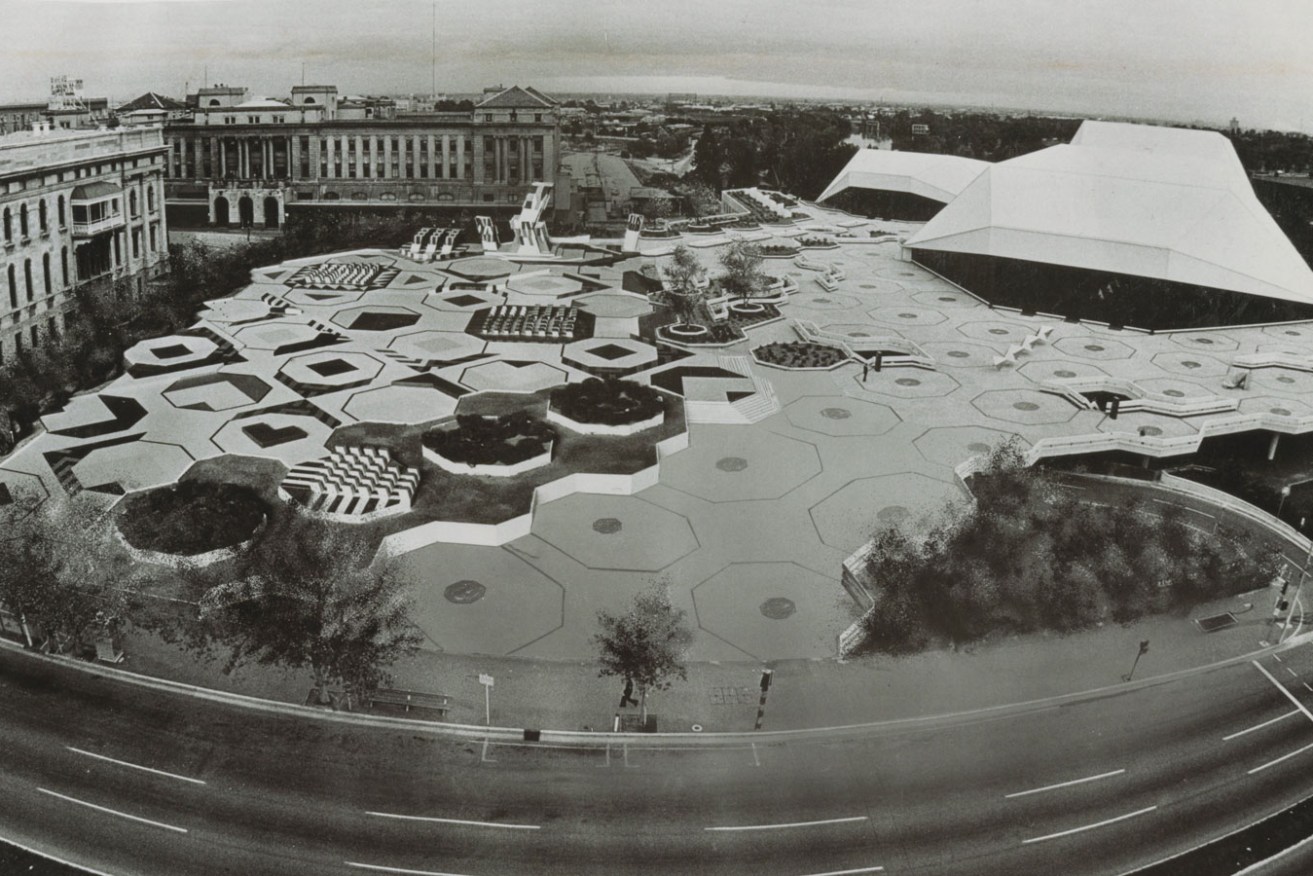
The Adelaide Festival Centre around the time of its completion, with Hajek Plaza in the foreground. Photo: supplied
It was a glittering, highly-anticipated occasion when the curtain was raised in Adelaide’s new home for the arts on June 2, 1973.
Two weeks earlier, around 40,000 South Australians had queued along King William Street to North Terrace to get their first look at the Adelaide Festival Centre’s Festival Theatre. It marked the completion of a three-year construction project based on the design of architect John Morphett, and the venue’s inaugural general manager, Anthony Steel, says it was the only topic of conversation in town at the time.
“The interest was enormous,” Steel says, adding that the opening night was “quite extraordinary… everybody was so excited to be part of this new venture”.
Prime Minister Gough Whitlam officially opened the Festival Theatre on June 2, sharing the stage with South Australian Premier Don Dunstan and other dignitaries. There followed a gala concert featuring works by Beethoven and Australian composer Richard Meale – with the performers including teenage drama student Douglas Gautier, now the Festival Centre’s CEO and artistic director.
The Dunstan Playhouse, Space Theatre and Amphitheatre were opened soon after the Festival Theatre, with the new Adelaide Festival Centre heralded as “Australia’s first multi-purpose arts centre”.
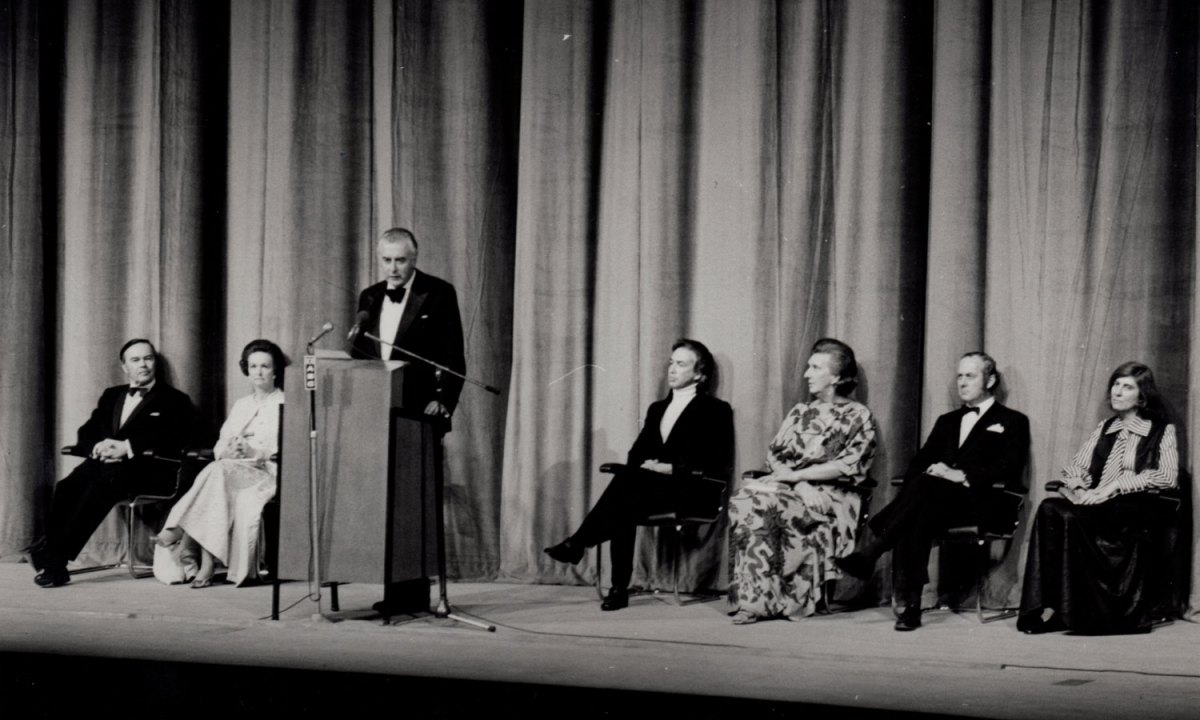
Gough Whitlam officially opens the Festival Theatre in 1973. Photo: Ballantyne and Partners
As the centre celebrates its milestone with a 50th anniversary concert tonight and a series of other events throughout the year, Steel, Gautier and others who have performed on its stages or have a close association with its history take a walk down memory lane:
Douglas Gautier, Adelaide Festival Centre CEO and artistic director
“On the opening night [in 1973], both Beethoven’s 9th Symphony and the second act of his only opera Fidelio were performed, to demonstrate the Festival Theatre could work as a concert hall as well as a lyric theatre.
“In the second act of the opera, the character Jaquino speaks but does not sing. It is a small part and they wanted to cast it locally with a young lad with blond hair – don’t ask me why! Anyway, they went to Flinders University Drama Centre to cast it, and I had blond hair – mainly because I was very much into surfing.
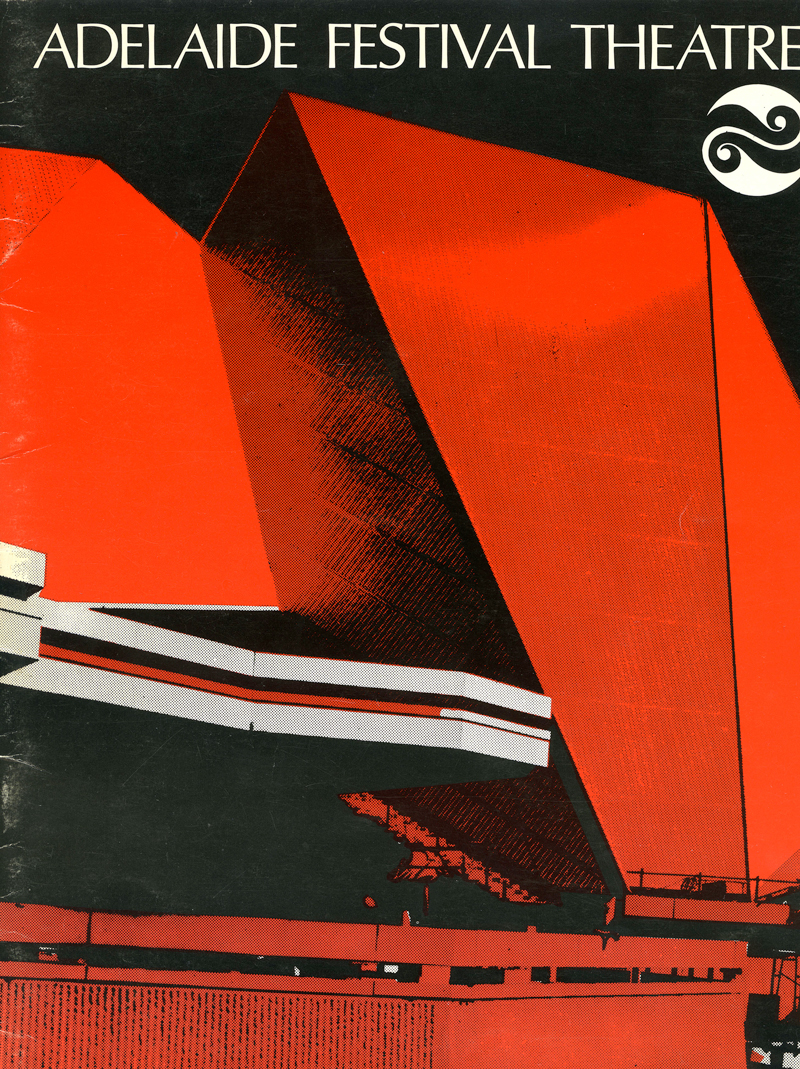
The 1973 Adelaide Festival Centre program.
“With my few lines, I shared the stage with some truly great Australian Opera singers – Nance Grant, Ronald Dowd, Neil Warren Smith and Raymond Myers – and an internationally renowned conductor, Georg Tintner.
“Many years later, when I became head of concert music for the Australian Broadcasting Corporation in Sydney in the late 1980s, Ronald Dowd and Ray Myers were extremely helpful and supportive to me in that job. They seemed to remember how we first met, but of course for me it was and is a magical memory. I loved every moment of the experience.
“Being involved in the opening performance of Adelaide Festival Centre’s Festival Theatre gave me a love for this place and belief in the ambition for it to be a great creative hub. That has never left me. This time, 50 years later, will be just as memorable and I’ll be watching from the audience and celebrating all that’s been and all that’s still to come for the heart of the arts in Adelaide.”
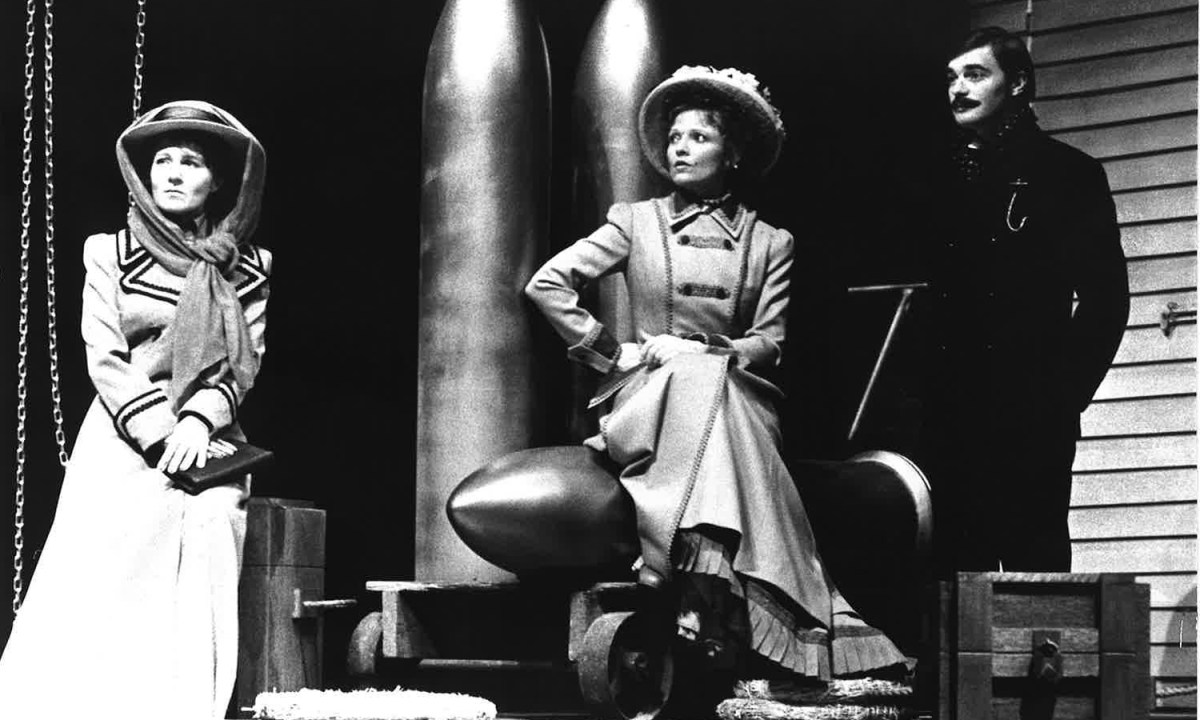
A young Douglas Gautier in Major Barbara at the Festival Centre in 1976. Photo: State Theatre Company of SA
Anthony Steel, first general manager of the Festival Centre and former artistic director of Adelaide Festival
“According to my records, one quarter of the population of the state came over two weekends [to see the Festival Centre before its official opening on June 2]. There were two good things about these numbers. First, it proved to us the huge interest of people in their new theatre, and second, all those feet tramping through removed much of the loose pile from the brand-new carpets!
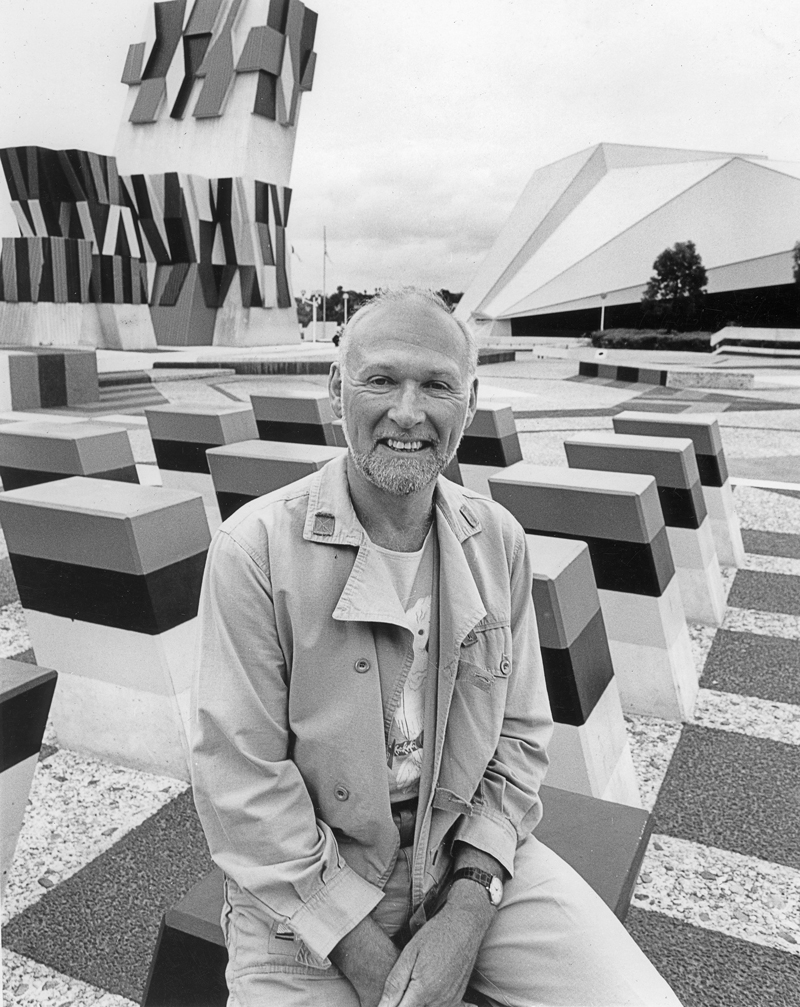
Anthony Steel outside the Festival Centre in 1977. Photo: William Yang
“After the opening weekend, when we showed off the theatre as both opera house and concert hall, I was able for the next six days to show it off as drama theatre, too. Peter Brooks’ legendary production of A Midsummer Night’s Dream for the Royal Shakespeare Company was touring Australia but they were proposing to bypass Adelaide as it was thought not likely to have a sufficient interest. I was able to persuade the tour manager that whether or not there were enough people to want to see the production, I could assure him there were thousands upon thousands eager to see their new theatre in action.
“A company I was particularly proud to bring to South Australia in the Festival Centre’s early days was Poland’s Cricot 2 under Tadeusz Kantor… they played a triumphant season of Kantor’s The Dead Class in the Space Theatre at my 1976 Adelaide Festival. A very large number of people still talk of it today with something approaching awe.”
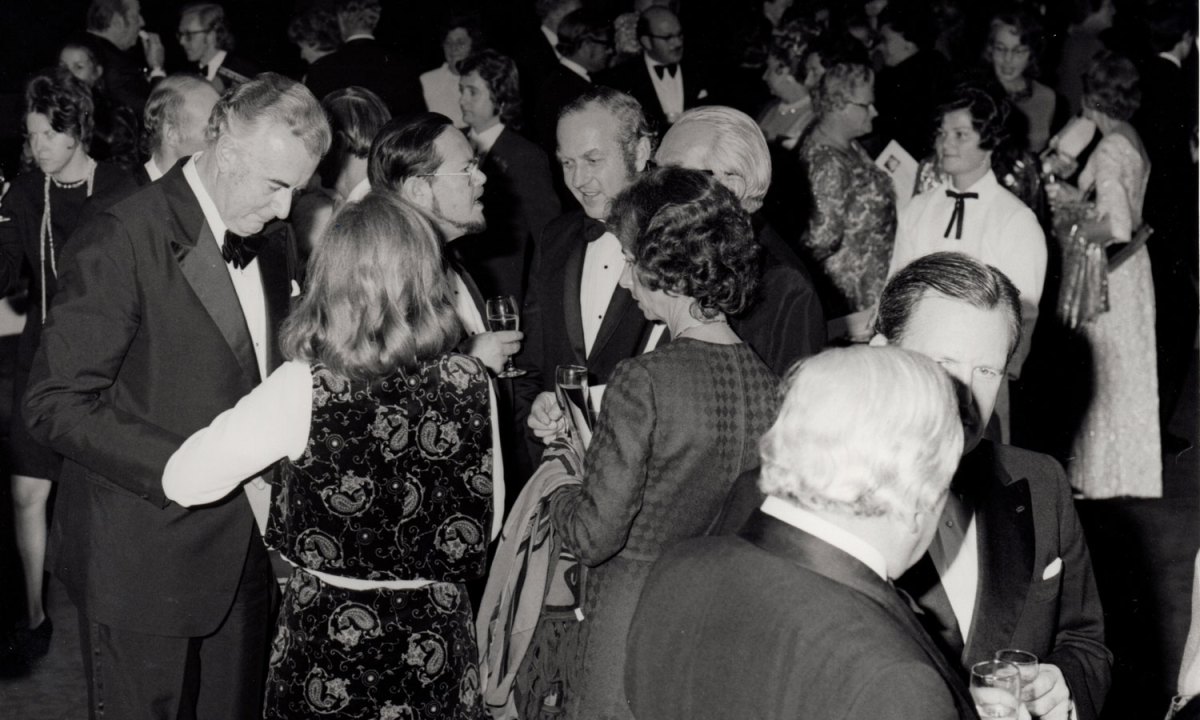
Guests, including Gough Whitlam, at the Adelaide Festival Centre’s opening night party. Photo: Ballantyne and Partners
Kate Ceberano, performer, former artistic director of Adelaide Cabaret Festival and co-artistic director of the 2023 Cabaret Festival
“The first time that I recall being presented at the Adelaide Festival Centre was by an entrepreneur named Clifford Hocking, who back in the day brought out Judy Garland and Frank Sinatra to Australia. I think he brought me out for the Adelaide Festival when I was a jazz artist. I remember thinking this place was just an epicentre of culture and I recall walking through the very brutal architecture feeling very impressed by how solid and heavy it was. It was very fun.
“I think my favourite time of all [at Adelaide Festival Centre] was performing during my tenure as artistic director during the Adelaide Cabaret Festival, because I felt so invested in the experience of helping other artists… I would walk them through spaces and tell them how to get in and around the place, and I would make sure that everyone had a cold bottle of Champagne in their rooms to celebrate their success afterwards. I felt really maternal in that space and it made me feel really proud. I will remember it for all of my life.
“My mother [Cherie] and her sister [Kaye] were water ballet girls like Esther Williams and they were involved in the Adelaide Festival Centre’s opening ceremony on the River Torrens. They did all their rehearsals in a beautiful blue pool – so you can imagine when all the swimmers came to the river and none of them could see anything under water! They just went every which way.”
Kate Ceberano will return to the Festival Centre this month for the Cabaret Festival show My Life is a Symphony.
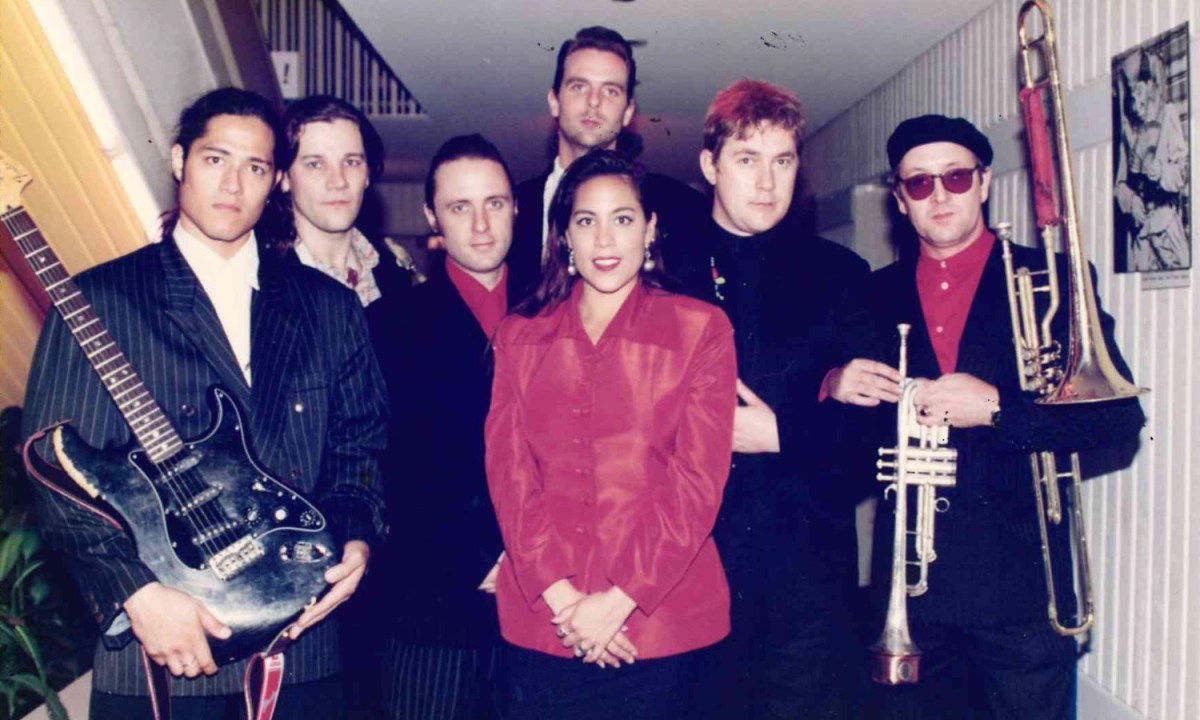
A young Kate Ceberano with her band at the Dunstan Playhouse. Photo: Heather Blewett
Robyn Archer, performer and former Adelaide Festival artistic director
“My professional career really began in this centre… I was invited to sing the lead in The Seven Deadly Sins, the production which opened Space Theatre [in 1974] in the new Adelaide Festival Centre, and it changed the direction of my career forever.
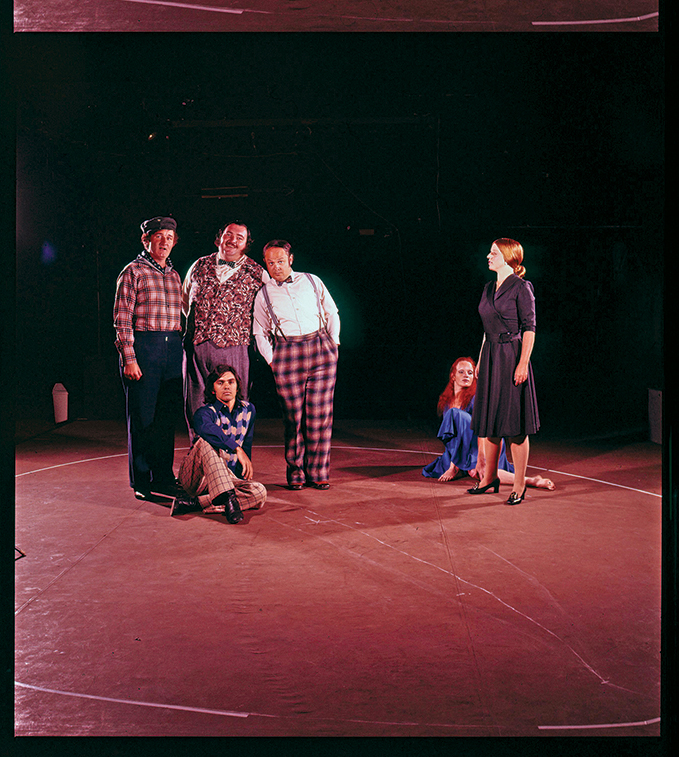
Robyn Archer, far right, in The Seven Deadly Sins on the opening night of the Festival Centre’s Space Theatre. Photo: supplied
“A year later, I met English dramaturg John Willett in the Playhouse production of The Threepenny Opera, and John invited me to the National Theatre in London – and my international career began. I wonder if any of that would have happened had there been no major cultural centre in Adelaide.
“At that time, I knew lots about entertainment, but little about the arts, and ever since I have sung, performed and directed on every stage and in every nook and cranny of Adelaide Festival Centre. The Adelaide Festival, which I directed in 1998 and 2000, would not be the enduring success it is without the Festival Centre, and 50 years on, the Dunstan Playhouse is still my very favourite venue anywhere. I’m proud to be treading its boards again during this year of celebration.”
Robyn Archer is presenting her show An Australian Songbook at the Dunstan Playhouse as part of the Cabaret Festival.
Todd McKenney, performer
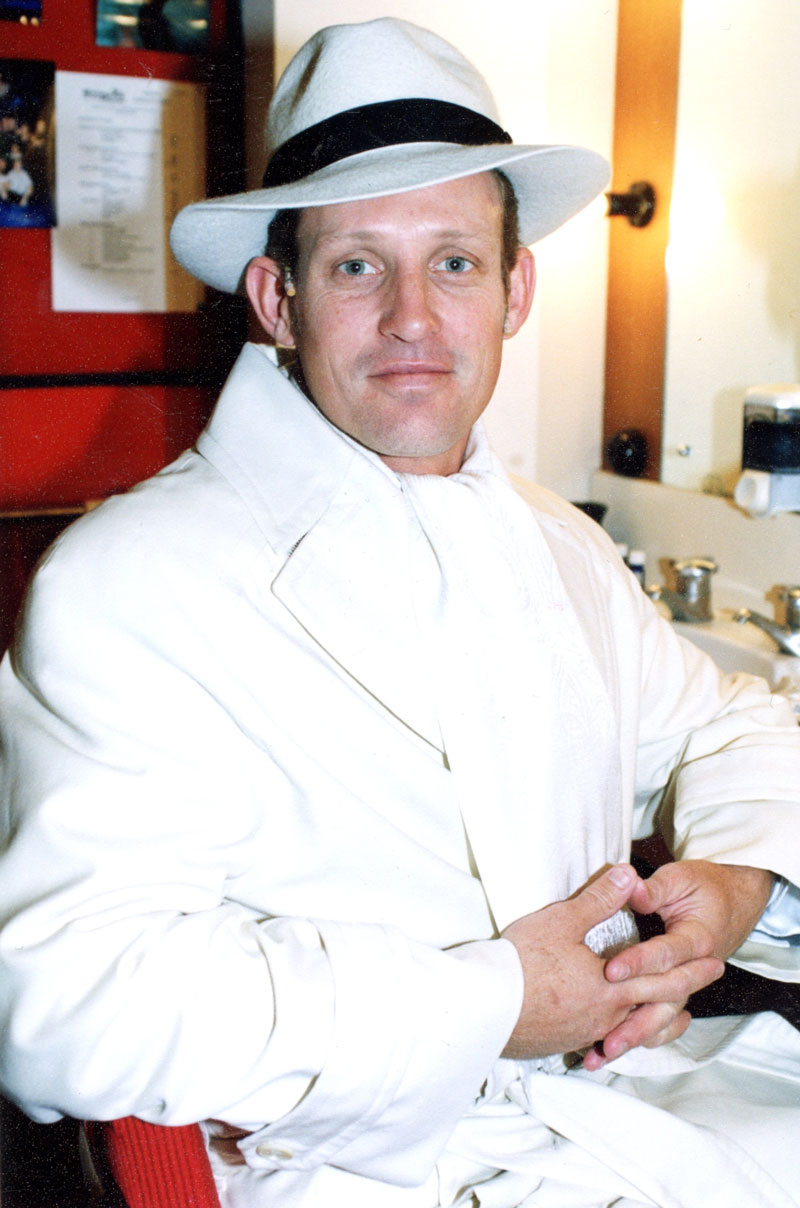
A young Todd McKenney at the Adelaide Festival Centre. Photo: Heather Blewett
“I was doing dance competitions in Perth and then I got a job as a DJ in a roller-skating rink and I was loving it. Then the owner of the roller-skating rink’s son had come to learn dancing at my mum’s dance studio and his mother saw an ad in The Australian saying there were auditions for an Andrew Lloyd Webber show called Song and Dance happening in Adelaide [in 1983]. I thought, ‘Why not?’, so I flew from Perth for the audition and I got the job. That changed everything.
“Rhonda [Burchmore] and I met in the greenroom at the Festival Theatre, which we still use today. The greenroom was a real hub of the whole place where everyone would gather. Adelaide Festival Centre had created a family of workers who were there through every show and were constant, so coming back to the same people who you had a history and friendship with was really gorgeous.
“Adelaide punches above its weight from an audience perspective as far as arts support goes. You have so much on here… keep cultivating that. Adelaide Festival Centre doesn’t seem 50 – she’s looking good!”
Rhonda Burchmore, performer
“My first big break was in a show called Sugar Babies [1988]. In it I had the bravest act… mind you, I quite enjoyed it. There were 18 pigeons and I used to sing a song called ‘Warm and Willing’ and as I removed a veil [of my costume] the pigeons would be released… they used to poo all over me! I had to go to bird training!
“This number really brought down the house. The show took me from here [the Adelaide Festival Centre] to London.”
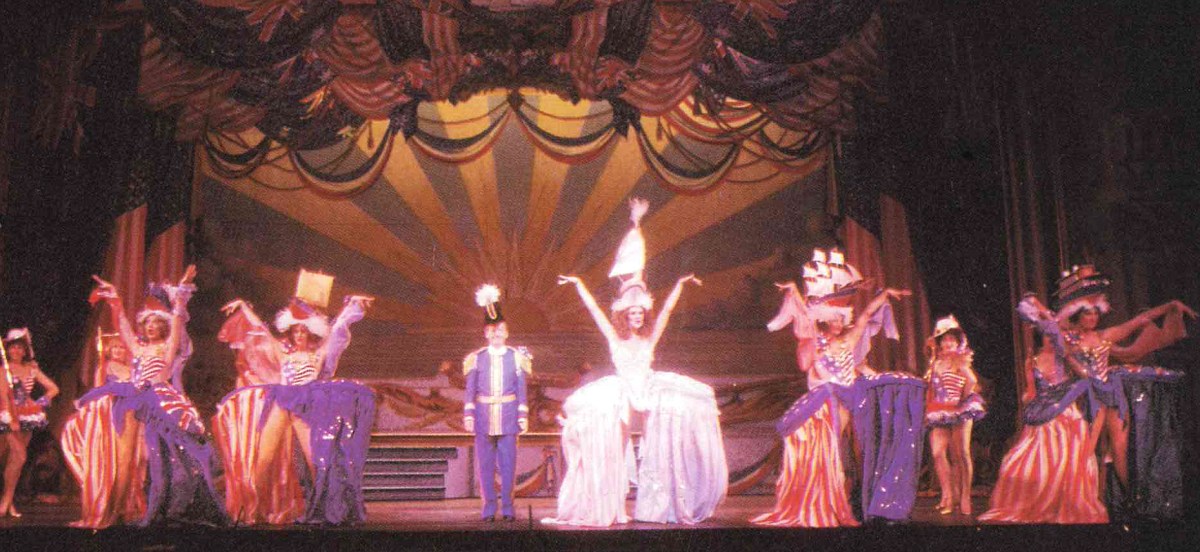
Rhonda Birchmore in a photo from the Sugar Babies program. Photo: supplied
Kathryn Sproul, designer
“I came to Adelaide in 1986 for work experience as a third-year NIDA design student for State Theatre. It was my first introduction to Adelaide, to the Adelaide Festival of Arts and to Adelaide Festival Centre, and it was the most beautifully integrated experience of arts, making it and putting it on. The facilities at Adelaide Festival Centre were amazing, the people were glorious and it motivated me to move to Adelaide and start my life professionally as a theatre designer. I have worked at Adelaide Festival Centre off and on now for 35 years because of that first experience.
“My first show as a professional designer was for Patch Theatre’s production of Wilfred Gordon McDonald Partridge in 1987 in the Space Theatre. I spent the first five to six years of my professional life working at Patch and Magpie Theatres, making theatre for young people, and that taught me about being brave and about being honest and making art that spoke to people’s hearts. Children are the first people who tell you if it works or not!”
Kathryn Sproul is currently working on the Adelaide Festival Centre 50th Anniversary Celebration Concert and the 2023 Variety Gala for Adelaide Cabaret Festival.
Lu Balsamo, ex-principal at Hassell – who was 25 and fresh out of architecture school when he came to work on the Festival Centre construction
“For a new graduate of architecture, it was exciting to work on one of the biggest and most unique projects undertaken in Adelaide at that time… Being responsible for major sections of the Drama Theatre [Dunstan Playhouse], all of the amphitheatre and then assisting John [designer John Morphett] on finishing the interiors of the Festival Theatre was more than any young architect could wish for.
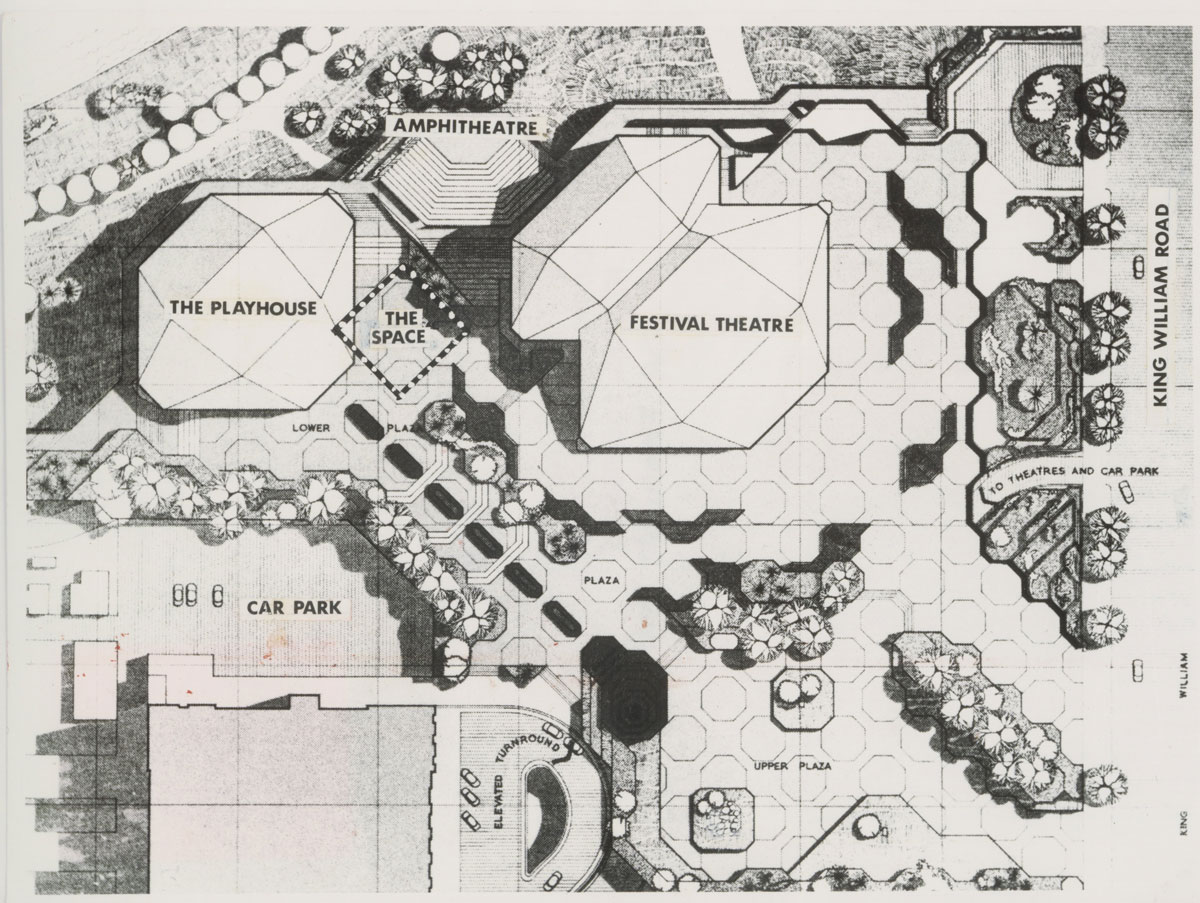
Adelaide Festival Centre construction plans.
“An Adelaide Festival of Arts occurred during the construction of the Drama Theatre. Premier Don Dunstan invited visiting Shakespearean theatre director Iain Mackintosh to view the theatre plans. In Colin Hassell’s office, Macintosh described how the single-tiered auditorium should have a balcony. This would allow the 500-seat theatre to be ‘dressed’ as 300 in the stalls, 200 in the balcony, or just 300 for smaller audiences by simply putting a curtain across the balcony front. It would also bring the audience at the rear of the balcony closer to the stage. He believed this would create a more intimate feel…
“Colin Hassell explained that the auditorium was already constructed and that any rework would entail ‘the sound of crashing concrete’. It could also affect the construction program. Dunstan’s will prevailed. David Hassell and I were asked to investigate three schemes each, to incorporate a balcony. Mackintosh returned a week or so later, before heading back to London, and selected the preferred design. ‘That one,’ he said, pointing to one of my schemes… we achieved the [three-week] deadline to complete the design after working an all-nighter.
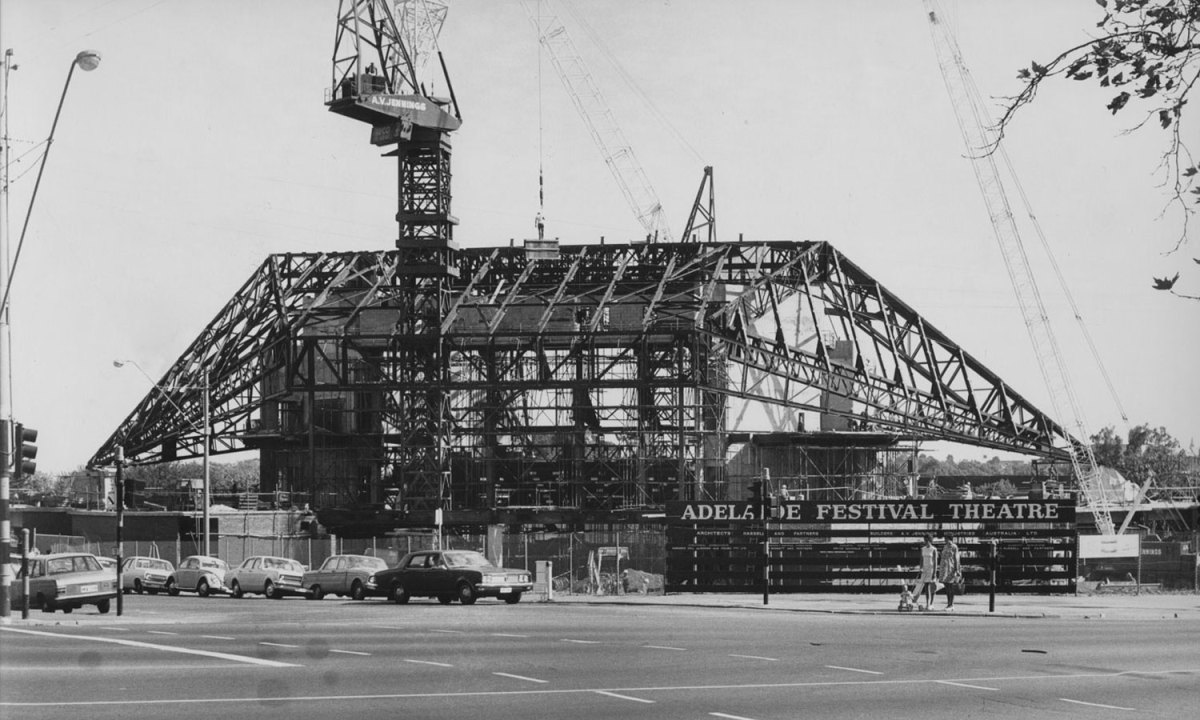
‘People were astounded at the size and shape of the steelwork’ – the Adelaide Festival Centre under construction. Photo: supplied
“[During construction of the Adelaide Festival Centre] people were astounded at the size and shape of the steelwork being erected. The local daily papers published photos continuously. Parts of the old SA Railways’ sheds and outbuildings had disappeared and Elder Park developed a new and interesting backdrop.
“So much excitement had been generated that when the theatre was opened for inspection to the public, the weekend after the gala Friday night opening concert, the queues stretched all the way up King William Street and along North Terrace.
“The Festivals of Arts had earned Adelaide a unique reputation within Australia and overseas. Now we would have a new multi-purpose performing arts venue, finished before the Sydney Opera House and of world standard.”
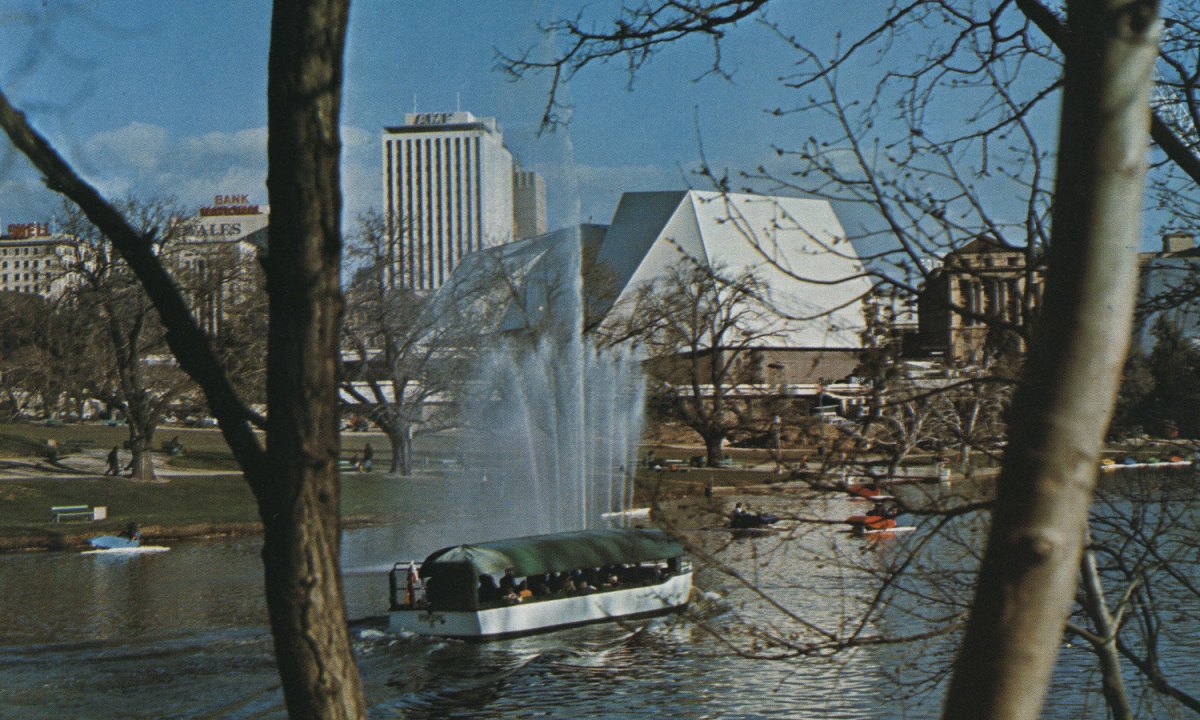
The Adelaide Festival Centre in the 1970s. Photo: supplied
Adelaide Festival Centre 50th Anniversary Celebration Concert is on June 2 in the Festival Theatre. The centre’s birthday will also be celebrated on June 9 at the Adelaide Cabaret Festival’s 2023 Variety Gala, which features five former Cabaret Festival artistic directors. Turn Up Your Radio, an exhibition of music memorabilia in the Festival Theatre Galleries from June 2 until August 12, captures memorable moments from Adelaide’s music scene over the past 50 years.




